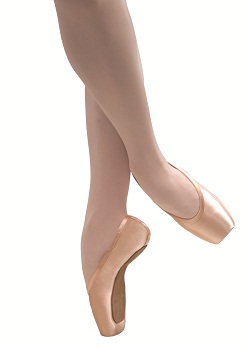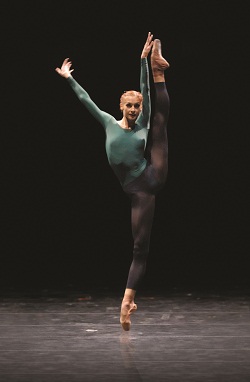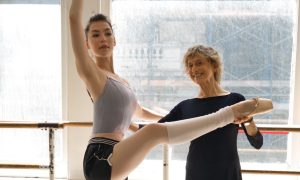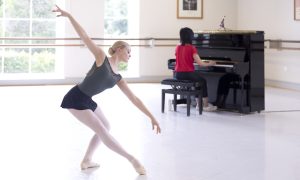By Leigh Schanfein.
Dance is usually considered a very traditional art form that seeks innovation as long as it does not compromise the integrity of the movement or the intent behind it. For each style of dance, this can mean something very different. And, for each choreographer and dancer, it can run the gamut from inspiration to forbidden territory. One place where innovation affects all styles of dance, and can even be quite controversial, is dancewear. What we put on our bodies affects how we use and view our bodies.
You probably recently heard about and saw a new and completely different “pointe shoe” design that was making the rounds online called the “Nike Arc Angel”. This sneaker-inspired pointe shoe had bunheads all atwitter as it was passed around like a good bit of gossip online. The design’s mockups caught on like wildfire as it brought up many opinions, questions, and debates – it does not look or even work like a pointe shoe since, aside from a box and vamp, there isn’t much more to it, and the materials more closely resemble roadwear than studiowear. Well, if you didn’t already know, I hate to dash your pointe-sneaker dreams, but those “Angels” are not real; they are a project by a design student named Guercy Eugene, who is not a classical dancer himself. All the buzz these fictional shoes aroused made me intrigued as to how dancewear incorporates the high-tech, and how designers realize their ideas. Unfortunately, Guercy wasn’t into answering questions about his design, but I spoke with several hugely influential designers about their work on transforming what we wear, and transforming dance as a result.

Gaynor Minden pointe shoes, photo by Elena Miranda
A name that is likely familiar to you, especially if you do ballet, is Eliza Minden, who lends her name to Gaynor Minden. Gaynor Minden is a standout in the world of innovative footwear having come out with the first major synthetic pointe shoe back in 1993. Surprisingly, Eliza is the only designer with whom I spoke who has a serious background in dance. But, what may have really given her an edge in developing her own product was growing up in a family that owns a manufacturing business. “I’ve spent hours in factories and was raised learning about how products are developed and produced.” Coming out with a revolutionary pointe shoe is as big a risk as it is a big step away from the traditions on which the shoe is founded. It was slow for the brand to gain acceptance, but making sure she stayed true to the aesthetic of ballet made it possible. “Ballet has an aesthetic and I respect that aesthetic. It would have been much easier to design pointe shoes if I hadn’t had to consider their looks. The aesthetic can change over time —for example Balanchine altered the look of the ballerina— but beautiful lines will always be part of it.”
A designer who agrees with Eliza about maintaining the traditional look is Dr. Matt Wyon, who along with his wife, Claire, has developed the Flyte pointe shoe, a brand new synthetic pointe shoe that replaces the traditional shank with a novel “spine” that resembles the protective structural component of a soccer goalie’s gloves. Matt is well-known within the dance science community for his research based in exercise physiology. As a researcher, he has worked with the English National Ballet and Birmingham Royal Ballet for the last 10-15 years, and he knew that the dancers had frustrations with their shoes that only lasted a day or two. Thus, he had one of his Masters’ students do a study asking dancers and instructors what changes they would like to see in their shoes, and made choices about design based on these needs. “In sport we can get away with unusual designs and looks as long as it performs well. It has actually taken longer to get the outer visually right than the inner technology!” And having a separate outer and inner allows for one of the things his team found dancers wanted – the inner (shank) can be kept and placed into multiple different outers that the dancer can change for a new look, such as to match a costume, or if it simply gets too dirty. “I wanted to create a shoe that worked for dancers, rather than a shoe that dancers had to put up with.
Someone who can design almost any sort of footwear imaginable is Lori Jacobs, an independent designer who has created some of the most innovative products produced by brands such as Reebok, Nike, Michelin, CAT, Ralph Lauren’s RLX, Polo Sport, Drew, and DKNY. She has designed everything from protective work boots to athletic sneakers, to fashion casuals! “I love trying new categories… Like most artists and innovators, we need to be challenged and always growing or we risk feeling stagnant.” Lori studied some dance as a youngster and studied modern, Afro Haitian, and Fuego along with her Industrial Design major at Syracuse University. Her familiarity with dance, staying active, and life-long study of Yoga has made her especially in tune with human movement and how energy emanates. “I still use body movement to design and feel from within and through my body, whether designing a jazz shoe, or gooseneck lamp.” Lori knew that movement was a huge inspiration for her design and that she should perhaps pursue dancewear design if that is what was within her heart to do. “It dawned on me that most designers do what is close to their heart, [for me] that was the dance, body movement, and funny enough, the most “shoe-less” you could be. That is how I found my way to the Capezio family.” If you’ve tried the brand-new “high-tech” Capezio Fizzion, then you’ve worn a Lori Jacobs design!
As a major dancewear company that has been providing for dancers since 1932, Bloch employs a whole team of designers led by the talented Jozette Hazzouri. Bloch’s designers come from a range of backgrounds, from dance to fashion, and they continually attend international events and trade shows to stay up on the latest ideas and get feedback from the Bloch sales force. The designers believe that “dance is in our DNA” and that innovations cannot be at the expense of performance. “Consumers think ‘high tech’ means that it assists their performance, and it does. In any sporting or dance field, consumers are looking at high tech ways to improve their craft. We try and help them do that by providing them with the latest technologies.” Ultimately, dancers will decide if a product is successful or not.

Yekaterina Kondaurova, 1st Soloist at the Mariinsky wears Gaynor Minden pointes. Photo by Neff
All of these designers were inspired to create, some as independents and some as part of a large manufacturer. Eliza Minden and Dr. Matt Wyon decided to strike out on their own to manufacture a product that they truly believe in. For both, a lot of time (years!) and many iterations (too many to count, says Eliza) went into the development of a single item. They had to know that there was a viable product that didn’t just intrigue us with its design, but actually served our needs, and they didn’t need a major manufacturer to step in. Eliza wanted to run and control her own business. She also knew that a major manufacturer wouldn’t be interested in a “low volume, tricky-to-fit, super specialized shoe, one that is subject to (from their point of view) capricious aesthetic requirements.” Matt also did not want to lose control of his design, but he decided to retain control to avoid having it quashed by more traditional-minded manufacturers. “There are a lot of good designs that never get to market because companies buy the rights to protect their own products” and they don’t want to turn their customers on to something new that’s out of their control. Sometimes being truly unique means you must strike out on your own.
Designers have to find a balance between tradition and innovation, and they have to keep in mind that their designs are not benign; they might actually change the art form. The designers at Bloch know that with every new product they create they are going to push at the established parameters, but no matter in what direction they go, they still have to remain faithful to their dance “DNA”. Not every design works, but they keep exploring. And this exploration can lead to a product that strikes a chord with dancers and can force the art form to evolve. Eliza Minden points out that “when dancers first began reinforcing the toe boxes of their slippers one hundred years ago, they were able to do much more, including steps that have become hallmarks of what we think of as ‘classical ballet’.” The engineering of our shoes has modified what dance is, just as engineering of instrumentation has modified music, physics and lens design have drastically changed photography, and electronics have modified all genres of art. Can we argue that the change is for the better? As consumers, if we continue to turn to the new products until they are not new but are the norm, we probably do so because we have found that they improve our performance. Dancers are an extremely demanding subset of consumers and we’re not going to settle for mediocrity in ourselves or our dancewear.
It seems to me that what makes a product truly innovative is when it serves our current needs while simultaneously surpassing them in a way that helps us improve our performance. As dancers, we depend on designers to understand this implicitly and help us achieve our best, because “high-tech” in itself doesn’t mean anything if it doesn’t translate into a more amazing experience on the stage.
Special thanks to Dr. Matt Wyon, Eliza Minden, Lori Jacobs, and the team at Bloch for their insight, Christopher Caines and Francisco Chateaubriand for their assistance.
Top photo: Dr. Matt Wyon’s The Flyte Pointe Shoe patented spine system.















